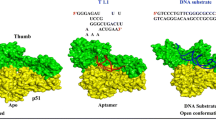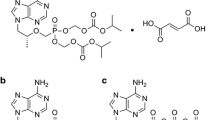Abstract
Human immunodeficiency virus (HIV)-1 reverse transcriptase (HIV-1 RT) is responsible for the transcription of viral RNA genomes into DNA genomes and has become an important target for the treatment of acquired immune deficiency syndrome (AIDS). This study used biophysical techniques to characterize the HIV-1 RT structure, monomer forms, and the non-nucleoside reverse transcriptase inhibitors (NNRTIs) bound forms. Inactive p66W401A and p51W401A were selected as models to study the HIV-1 RT monomer structures. Nuclear magnetic resonance (NMR) spectroscopy revealed that the unliganded forms of p66W401A protein and p51W401A protein had similar conformation to each other in solution. The complexes of p66W401A or p51W401A with inhibitors showed similar conformations to p66 in the RT heterodimer bound to the NNRTIs. Furthermore, the results of paramagnetic relaxation enhancement (PRE)-assisted NMR revealed that the unliganded forms of the p66W401A and p51W401A conformations were different from the unliganded heterodimer, characterized by a greater distance between the fingers and thumb subdomains. Small-angle X-ray scattering (SAXS) experiments confirmed that p66W401A and p51W401A can bind with inhibitors, similar to the p66/p51 heterodimer. The findings of this study increase the structural knowledge base of HIV-1 RT monomers, which may be helpful in the future design of potent viral inhibitors.





Similar content being viewed by others
References
Sarafianos SG, Das K, Ding J, Boyer PL, Hughes SH, Arnold E (1999) Touching the heart of HIV-1 drug resistance: the fingers close down on the dNTP at the polymerase active site. Chem Biol 6:R137–R146
Sarafianos SG, Clark AD Jr, Tuske S, Squire CJ, Das K, Sheng D, Ilankumaran P, Ramesha AR, Kroth H, Sayer JM, Jerina DM, Boyer PL, Hughes SH, Arnold E (2003) Trapping HIV-1 reverse transcriptase before and after translocation on DNA. J Biol Chem 278:16280–16288
Sarafianos SG, Marchand B, Das K, Himmel DM, Parniak MA, Hughes SH, Arnold E (2009) Structure and function of HIV-1 reverse transcriptase: molecular mechanisms of polymerization and inhibition. J Mol Biol 385:693–713
Bauman JD, Patel D, Dharia C, Fromer MW, Ahmed S, Frenkel Y, Vijayan RS, Eck JT, Ho WC, Das K, Shatkin AJ, Arnold E (2013) Detecting allosteric sites of HIV-1 reverse transcriptase by X-ray crystallographic fragment screening. J Med Chem 56:2738–2746
Das K, Martinez SE, Bandwar RP, Arnold E (2014) Structures of HIV-1 RT-RNA/DNA ternary complexes with dATP and nevirapine reveal conformational flexibility of RNA/DNA: insights into requirements for RNase H cleavage. Nucleic Acids Res 42:8125–8137
Xavier Ruiz F, Arnold E (2020) Evolving understanding of HIV-1 reverse transcriptase structure, function, inhibition, and resistance. Curr Opin Struct Biol 61:113–123
Tuske S, Zheng J, Olson ED, Ruiz FX, Pascal BD, Hoang A, Bauman JD, Das K, DeStefano JJ, Musier-Forsyth K, Griffin PR, Arnold E (2020) Integrative structural biology studies of HIV-1 reverse transcriptase binding to a high-affinity DNA aptamer. Curr Res Struct Biol 2:116–129
Karade S, Chaturbhuj DN, Sen S, Joshi RK, Kulkarni SS, Shankar S, Gangakhedkar RR (2018) HIV drug resistance following a decade of the free antiretroviral therapy programme in India: a review. Int J Infect Dis 66:33–41
Pennings PS (2013) HIV drug resistance: problems and perspectives. Infect Dis Rep 5:e5
Sluis-Cremer N, Arion D, Parniak MA (2002) Destabilization of the HIV-1 reverse transcriptase dimer upon interaction with N-acyl hydrazone inhibitors. Mol Pharmacol 62:398–405
Depollier J, Hourdou ML, Aldrian-Herrada G, Rothwell P, Restle T, Divita G (2005) Insight into the mechanism of a peptide inhibitor of HIV reverse transcriptase dimerization. Biochemistry 44:1909–1918
Divita G, Restle T, Goody RS, Chermann JC, Baillon JG (1994) Inhibition of human immunodeficiency virus type 1 reverse transcriptase dimerization using synthetic peptides derived from the connection domain. J Biol Chem 269:13080–13083
Morris MC, Berducou C, Mery J, Heitz F, Divita G (1999) The thumb domain of the P51-subunit is essential for activation of HIV reverse transcriptase. Biochemistry 38:15097–15103
Braz VA, Holladay LA, Barkley MD (2010) Efavirenz binding to HIV-1 reverse transcriptase monomers and dimers. Biochemistry 49:601–610
Braz VA, Barkley MD, Jockusch RA, Wintrode PL (2010) Efavirenz binding site in HIV-1 reverse transcriptase monomers. Biochemistry 49:10565–10573
Tachedjian G, Mijch A (2004) Virological significance, prevalence and genetic basis of hypersusceptibility to nonnucleoside reverse transcriptase inhibitors. Sex Health 1:81–89
London RE (2016) Structural maturation of HIV-1 reverse transcriptase-a metamorphic solution to genomic instability. Viruses. https://doi.org/10.3390/v8100260
Srivastava S, Sluis-Cremer N, Tachedjian G (2006) Dimerization of human immunodeficiency virus type 1 reverse transcriptase as an antiviral target. Curr Pharm Des 12:1879–1894
Zheng X, Mueller GA, Cuneo MJ, Derose EF, London RE (2010) Homodimerization of the p51 subunit of HIV-1 reverse transcriptase. Biochemistry 49:2821–2833
Zheng X, Pedersen LC, Gabel SA, Mueller GA, Cuneo MJ, DeRose EF, Krahn JM, London RE (2014) Selective unfolding of one ribonuclease H domain of HIV reverse transcriptase is linked to homodimer formation. Nucleic Acids Res 42:5361–5377
Silprasit K, Thammaporn R, Tecchasakul S, Hannongbua S, Choowongkomon K (2011) Simple and rapid determination of the enzyme kinetics of HIV-1 reverse transcriptase and anti-HIV-1 agents by a fluorescence based method. J Virol Methods 171:381–387
Thammaporn R, Yagi-Utsumi M, Yamaguchi T, Boonsri P, Saparpakorn P, Choowongkomon K, Techasakul S, Kato K, Hannongbua S (2015) NMR characterization of HIV-1 reverse transcriptase binding to various non-nucleoside reverse transcriptase inhibitors with different activities. Sci Rep 5:15806
Seetaha S, Yagi-Utsumi M, Yamaguchi T, Ishii K, Hannongbua S, Choowongkomon K, Kato K (2016) Application of site-specific spin labeling for NMR detecting inhibitor-induced conformational change of HIV-1 reverse transcriptase. ChemMedChem 11:363–366
Yagi-Utsumi M, Kameda T, Yamaguchi Y, Kato K (2010) NMR characterization of the interactions between lyso-GM1 aqueous micelles and amyloid b. FEBS Lett 584:831–836
Goddard TD, Kneller DG (2008) SPARKY 3. University of California, San Francisco, CA
Hopkins JB, Gillilan RE, Skou S (2017) BioXTAS RAW: improvements to a free open-source program for small-angle X-ray scattering data reduction and analysis. J Appl Crystallogr 50:1545–1553
Petoukhov MV, Franke D, Shkumatov AV, Tria G, Kikhney AG, Gajda M, Gorba C, Mertens HD, Konarev PV, Svergun DI (2012) New developments in the ATSAS program package for small-angle scattering data analysis. J Appl Crystallogr 45:342–350
Manalastas-Cantos K, Konarev PV, Hajizadeh NR, Kikhney AG, Petoukhov MV, Molodenskiy DS, Panjkovich A, Mertens HDT, Gruzinov A, Borges C, Jeffries CM, Svergun DI, Franke D (2021) ATSAS 3.0: expanded functionality and new tools for small-angle scattering data analysis. J Appl Crystallogr 54:343–355
Svergun D, Barberato C, Koch MHJ (1995) CRYSOL—a program to evaluate X-ray solution scattering of biological macromolecules from atomic coordinates. J Appl Crystallogr 28:768–773
Franke D, Svergun DI (2009) DAMMIF, a program for rapid ab-initio shape determination in small-angle scattering. J Appl Crystallogr 42:342–346
Volkov VV, Svergun DI (2003) Uniqueness of ab initio shape determination in small-angle scattering. J Appl Cryst 36:860–864
Cabodevilla JF, Odriozola L, Santiago E, Martinez-Irujo JJ (2001) Factors affecting the dimerization of the p66 form of HIV-1 reverse transcriptase. Eur J Biochem 268:1163–1172
Zheng X, Mueller GA, DeRose EF, London RE (2009) Solution characterization of [methyl-(13)C]methionine HIV-1 reverse transcriptase by NMR spectroscopy. Antiviral Res 84:205–214
Chiang CC, Wang SM, Tseng YT, Huang KJ, Wang CT (2009) Mutations at human immunodeficiency virus type 1 reverse transcriptase tryptophan repeat motif attenuate the inhibitory effect of efavirenz on virus production. Virology 383:261–270
Acknowledgements
This work was financially supported by the Kasetsart University Research and Development Institute (KURDI), Bangkok, Thailand (FF (KU)17.64); the Office of the Ministry of Higher Education, Science, Research and Innovation; and the Thailand Science Research and Innovation through the Kasetsart University Reinventing University Program 2021. This work was also supported by Joint Research by Exploratory Research Center on Life and Living Systems (ExCELLS) (ExCELLS program No, 19-310), and the Nanotechnology Platform Program (Molecule and Material Synthesis) of MEXT, Japan for the NMR experiments.
Author information
Authors and Affiliations
Corresponding author
Ethics declarations
Conflict of interest
The authors declare that they have no conflicts of interest.
Ethical Approval
This article does not contain any studies with human participants or animals performed by any of the authors.
Additional information
Publisher’s Note
Springer nature remains neutral with regard to jurisdictional claims in published maps and institutional affiliations.
Rights and permissions
Springer Nature or its licensor (e.g. a society or other partner) holds exclusive rights to this article under a publishing agreement with the author(s) or other rightsholder(s); author self-archiving of the accepted manuscript version of this article is solely governed by the terms of such publishing agreement and applicable law.
About this article
Cite this article
Seetaha, S., Kamonsutthipaijit, N., Yagi-Utsumi, M. et al. Biophysical Characterization of p51 and p66 Monomers of HIV-1 Reverse Transcriptase with Their Inhibitors. Protein J 42, 741–752 (2023). https://doi.org/10.1007/s10930-023-10156-y
Accepted:
Published:
Issue Date:
DOI: https://doi.org/10.1007/s10930-023-10156-y




